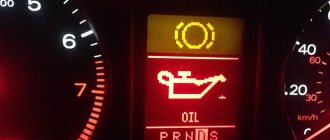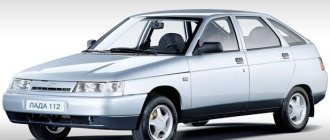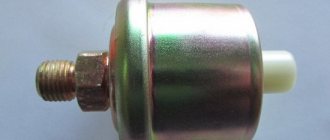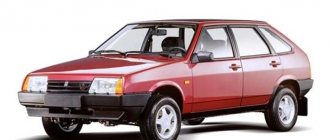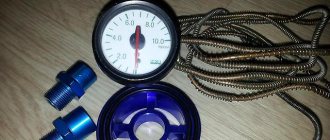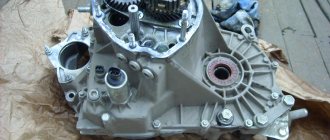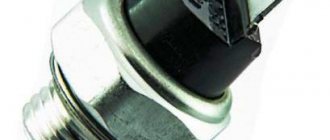The oil pressure sensor (OPS) is designed to monitor the condition of the oil in the engine. As soon as the oil level drops, a warning lamp lights up on the instrument panel, indicating the need to add oil, or check the condition of the sensor itself or its circuit.
DDM is one of those parts that do not often fail, so many motorists during the period of ownership of the car do not even guess where it is installed.
If you had to deal with the problem of sensor failure, our article will be useful for you.
Checking and replacing the oil pressure sensor Lada Kalina
The engine is designed so that without a lubrication system it cannot perform its functions, and for monitoring, a pressure sensor is installed, which warns of the presence of pressure with a warning light on the instrument panel.
The sensor is not a complex structure; a membrane, a rod and contacts are installed inside; when there is no pressure in the system, the contacts are closed and the light comes on when the ignition is turned on. After starting, the oil under pressure presses on the membrane, and it opens the contacts through the rod and the light goes out, this is a signal that pressure has appeared in the system.
There are times when a light may come on after starting the engine or while driving; in such cases, it is necessary to turn off the engine and determine the malfunction.
Let the engine cool and check the oil in the engine using the marks on the dipstick, unscrew the sensor and check it using the old-fashioned method, lightly cover the hole with your finger and crank it with the starter without starting the engine.
To do this, remove the connector from the ignition module so that the engine does not start, otherwise you won’t be able to hold it with your finger if it starts. The oil should press on your finger, leaking slightly, which means there is pressure in the system; if not, then the problem is even deeper and it is not recommended to start the engine.
You can check with a mechanical pressure gauge by twisting it instead of the sensor, the pressure should be 0.6 kg/cm and higher at low speeds, but not everyone has a pressure gauge to check, there is no better than the old-fashioned method.
The sensor itself may fail or the wire may be broken to ground; inside, through the membrane, oil may enter the second cavity where the contacts are located and it prevents the movement of the membrane.
Checking the sensor involves connecting a 12-volt light bulb and creating a pressure of one atmosphere.
We connect one wire from the light bulb to the sensor terminal, the second to the positive of the battery, and the negative from the battery to the sensor body, the light should be on.
We put a hose on the threaded part and apply air pressure to the sensor; you can create pressure with a pump. Once the pressure is created, the light goes out, the sensor is working, if not, then we buy a new one and put it in place, changing the sensor does not require much effort.
Source: https://ego-yuriie.ru/kalina/proverka-i-zamena-datchika-davleniya-masla-lada-kalina.html
Let's look at different situations in which the battery light comes on.
- Situation one - the on-board voltmeter shows the charge, the battery light does not light up, the multimeter shows 12V at the battery terminals, while the battery itself is completely discharged.
- Situation two - the light and the light indicate charging, but the battery is discharged. The voltage on the battery is normal (~14V), but when there is a load (signal, headlights, etc.) the charging arrow jerks to the extreme left position. The reason is poor tension of the generator belt, or a problem with the pulley or bearing itself.
- In addition, the cause of the above situation may be a breakdown of one of the diodes or a break in the stator winding. Do the following - turn off the ignition, then check the diodes with a multimeter; if a breakdown is detected, replace them.
- It would be a good idea to check the generator brushes. To do this, simply remove the brushes and check their length, if the length is less than five mm. I recommend replacing the generator brushes.
- Situation three - after turning the key in the ignition, the battery lamp does not light up, while the charge sensor does not work, and the battery does not charge. The most likely cause is a blown fuse. It is designated “F10”, its rating is 10 Amp. If after replacing a new fuse you do not see any result, the reason may lie in the lock itself or the ignition relay.
- Situation four - after turning the key there is no charging, but all devices are functioning, the battery light does not light up.
Oil pressure sensor in a car engine
Treatment: Remove the wiring from terminal “61” of the generator, and then connect it directly to the negative (that is, to the body). If after this the lamp lights up, the reason is in the excitation winding of the generator.
The reason may also be poor contact in the connector. It is necessary to clean everything properly and check the result; if it is not there, it is very possible that the lamp has burned out. If the problem is not in the light bulb (it burns dimly or intermittently), then other indicators will also light dimly or intermittently; if this only happens with the battery indicator, then perhaps the reason is in the light bulb itself.
- Situation five - after turning on the ignition, the battery light comes on, and after starting the engine it does not go out, while charging is either intermittent or does not exist at all. The reason for this behavior may be poor contact of the wire with the connector on the dashboard.
After all the above checks, check the relay regulator and apply voltage to its contacts. Check the voltage on the brushes, if it is 12V, the relay is working properly. Otherwise, replace the relay regulator.
Oil pressure sensor Kalina
The oil pressure sensor on Kalina is also called an emergency oil pressure sensor. It does not display what pressure the engine oil is under. Its main task is to light the emergency oil pressure lamp on the dashboard if the engine oil pressure becomes critically low. This means that it is time to change the oil or its level has dropped below min.
The emergency oil pressure indicator may operate falsely. In this case, the oil pressure sensor (OPS) has failed. How can this be checked?
Oil pressure sensor on Kalina 8kl
The DDM on the Kalinovsky 8-valve engine is located on the back side of the engine, just above the exhaust manifold of the 1st cylinder. How to check its functionality? We unscrew the sensor and screw in the pressure gauge in its place.
Let's start the engine. At idle, the oil pressure should be around 2 bar. At maximum speed - 5-6 bar.
If the pressure gauge shows these numbers and the light on the dashboard is still on, the oil pressure sensor is not correct and must be replaced.
Naturally, before such a check, you need to make sure that high-quality oil is poured in and that its level is between the min & max stripes on the dipstick.
Oil leak from oil pressure sensor
The second common failure is an oil leak from under the sensor. In this case, the exhaust manifold of the 1st cylinder, the upper part of the pump, and the left side of the engine protection will be in oil. The sensor itself and the wire leading to it will also be covered in oil.
If you find oil leaks in the area of the first cylinder, make sure that it is not the camshaft or crankshaft seal, it is not leaking from under the valve cover gasket, or, which is much worse, the cylinder head, then in 99 cases out of 100 the fault will be a broken oil pressure sensor.
Replacing the water pump Lada Kalina
On an 8-valve VAZ-21114 engine, the average service life of the water pump is about 70-100 thousand km, and if it starts to make noise or leak, it must be replaced. It should be noted that on all models 2108-15, Lada Priora and Kalina with an 8-valve internal combustion engine, the pump is changed according to the same principle.
The water pump is replaced as follows:
- drain the antifreeze from the cooling system;
- remove the plastic timing belt cover;
- if the timing belt does not need to be changed, then we do not remove the crankshaft pulley; accordingly, there is no need to dismantle the right wheel;
- set a mark on the camshaft - it should coincide with the ebb on the rear timing case;
- loosen the tension roller, remove the belt from the camshaft;
- Unscrew the three pump mounting bolts with a hexagon and remove the pump;
- put the new pump in place, put on the belt, tighten it with a tension roller, check the alignment of the marks, on the crankshaft the mark is located on the flywheel, under the rubber plug of the gearbox housing;
- fill in antifreeze, start the engine, check if the antifreeze is leaking and if the pump is noisy. If everything is in order, put the timing case back in place.
How to Change the Oil Pressure Sensor on Kalina
17 Oct
Oil pressure
sensor Lada Kalina
Here } myth sensor
Today, a wonderful in every respect, stylish, multifunctional and easy-to-use domestically produced car, the Lada Kalina remains very popular among our customers.
Thanks to good build quality and excellent technical performance, Kalina has earned the attention and respect of a multi-million army of car enthusiasts.
We will talk about this machine and how to maintain its working condition.
What most affects the viability of a car? engine oil comes first
.
Therefore, the questions: at what time to change the lubricant, which one to choose for Kalina, in addition, what is pressure
sensor and why is it needed, are the most relevant.
Why does a car need oil and additives?
Motor oil keeps your engine healthy
Any driver knows that engine oil is very important for a Lada Kalina car. However, why exactly is it needed? Due to its stabilizing, solubilizing and washing properties, the lubricant ensures the process of cleaning the engine from all kinds of contaminants, which significantly increases the service life of the engine.
The oil guarantees normal pumpability if a cold start is necessary, and additionally makes the engine more durable under all kinds of loads and extreme operating conditions. A positive property of the lubricant is its viscous structure and ability to remain effective at almost any temperature.
KEY-DOP
Oils for Kalina improve performance in the crankcase and cylinder-piston areas.
Thanks to its high thermal-oxidative and thermal stability, motor oil allows the power unit to operate without failures in the presence of not only extreme cold, but also the same heat.
The lubricant neutralizes the corrosion process, protects the engine from the harmful effects of oxygen and water and therefore makes its operation more reliable.
Lada Kalina oil pressure sensor replacement self-diagnosis
LADA KALINA
REPLACING
THE OIL PRESSURE SENSOR
INDEPENDENT DIAGNOSTICS HOW
THE SENSOR
.
Today there are several types of motor oils. In order for them to be effective and cope with the work tasks assigned to them, functional additives are added to lubricants of any category. This is a mixture of various compounds on which the quality of motor oil
.
Additives also come in several types.
- Detergents. Their task is to systematically clean the engine during its operation. The higher the proportion of these substances, the less sediment remains in the used oil and the less harmful deposits of all kinds are formed in engine parts.
- Antioxidant. They prevent the aging of the power unit, making it more durable and hardy. Prevents oxidation of the lubricant, which often leads to serious engine problems.
- Dispersing. The effect of these additives is quite broad; they significantly increase the service life of the engine.
- Anti-friction. These are special modifiers that reduce friction, which is one of the main reasons for the rapid wear of engine parts.
- Anti-corrosion. Eliminates the possibility of rust harmful to the engine.
- Anti-foam.
- Thickening. Through the viscosity of the composition, these modifiers allow the engine to perform equally well in both the merciless heat and the Siberian cold. The more thickening substances the oil contains, the easier the cold start is and the more reliable the engine operates under intense loads.
How to change the oil pressure sensor on a Kalina
Source: https://autoruservis.ru/kak-pomenjat-datchik-davlenija-masla-na-kaline/
Location
Where the oil pressure sensor is located depends on the number of cylinders. On 4-cylinder engines, the device is located on one side of the engine. This is a small plastic electrical connection that is secured to the motor with a screw. 6 cylinder engines have a device under the spark plug wires attached to one side of the valve cover.
How to Remove the Oil Pressure Sensor on Kalina
What if the oil pressure sensor lights up on a Lada Kalina?
What is a Kalina oil pressure sensor (DDM) is something that many car enthusiasts only imagine in general terms. Often, Kalina owners, without reading the booklet attached to the car when it was purchased at the showroom, do not even know what icon on the dashboard it represents. Although you can guess this without reading the instructions.
But for beginners it can be difficult. Therefore, if Lada Kalina. If this is your first car, it is better to read the instructions carefully. In this case, it is advisable to be near the car.
What the driver should do when the pressure light comes on
What should I do if the oil pressure light comes on on the dashboard? What does it mean?
Typically, the indicator lamp lights up for a few seconds. This does not pose a threat to the vehicle's power supply. But if the pressure lights up for a longer period of time, it means that there may be serious problems with the engine.
You must stop immediately and turn off the ignition. If the emergency pressure sensor comes on while driving, it means that there is some kind of problem.
Most likely, there is not enough engine oil in the power unit, which is washed by the crankshaft, pistons and other parts. An insufficient amount of it leads to very rapid damage to the friction of parts.
As motorists say, with insufficient oil, you can easily “screw the engine.”
After the engine has cooled (after 10-15 minutes, when you can touch the power supply head), measure the oil
using a measuring probe.
If the level is below the minimum level, add lubricant. It should always be in the trunk of every car owner.
When the oil level is at o and min, you need to start the car again. If the pressure gauge comes on again, the engine must be stopped and a tow truck called or requested to transport the vehicle to the nearest service station. They will be able to understand the reasons for the loss of oil pressure in the power supply.
Lada Kalina oil pressure sensor replacement self-diagnosis
LADA KALINA
REPLACING
THE OIL PRESSURE SENSOR
INDEPENDENT DIAGNOSTICS HOW
THE SENSOR
.
Lada Kalina. The oil pressure sensor came on
I almost reached the city and the oil pressure gauge
. Thanks to the videos on YouTube. Thanks to them, I immediately assumed.
If you continue to drive even a short distance, it could cause serious problems and significant repair costs in the future.
Testing DDM performance on Kalina
Sometimes the burning of the oil pressure sensor light does not at all indicate some malfunction in the car engine.
Lada Kalina may be clogged. But usually it changes along with the oil in the engine.
Suddenly the oil pump may be damaged. This is a serious problem. And it is important to notice this in time, before a knock appears in the engine. If the malfunction is noticed in a timely manner, immediately send the vehicle to a repair shop.
The problem could also be a problem with the sensor itself. And this is the least of all problems. You can simply check its operation.
The DDM has a membrane onto which oil is compressed to clean the engine. This membrane, in turn, creates pressure on the electrical contacts, closing or opening them.
The pressure in the system can be checked using a pressure gauge. To do this, disconnect DDM and connect the pressure gauge. The indicators on the instrument with the engine idling must be at least 0.65 kgf/cm². If everything is fine in this regard, then DDM is not working correctly and needs to be changed.
Broken fuel tank seal, catalytic converter failure
If the check persists on the dashboard, the car owner will look for a problem with the engine. But the reason may be different. The check engine light may come on due to problems with the tightness of the fuel system. The fuel filler cap may not be securely closed. Why does this problem occur? The reasons may be the following.
- If the seal of the fuel system is broken, air begins to flow into it.
- Additional fuel consumption appears.
- Air in the fuel system causes engine problems.
- The check engine light comes on on the dashboard.
How to fix the problem? If the check engine light is on and there are no signs of loss of power, knocking, humming or squeaking, then you need to check how tightly the gas tank is sealed. Sometimes, in a hurry, the driver simply forgets to close the lid tightly, or cracks begin to appear on it. If you have fixed the problem, but the check continues to light, then this is not the reason.
What to do if the catalyst fails? A car catalyst is needed to neutralize exhaust gases. The oxide contained in exhaust contains many substances that are harmful to the environment. The catalyst reduces the damage that a running vehicle causes to the environment.
If the check light is on due to a faulty catalyst, you will notice that the engine power has dropped significantly. The car loses acceleration dynamics. What is the reason for catalyst failure? Regular technical inspection of the vehicle will ensure that such a malfunction does not occur.
One of the reasons for catalyst failure is a breakdown of the oxygen sensor. Old spark plugs can cause catalytic converter failure. You should not take this problem lightly. If the oxygen sensor or spark plugs malfunction, the process of neutralizing exhaust gases is disrupted.
Where is the Oil Pressure Sensor on Kalina ~ AUTOINTERLINE.RU
where is the oil pressure sensor in the photo Kalina
Sometimes it happens that on the dashboard of the car, at idle or immediately after starting the engine, the oil pressure sensor
lamp.
Determine the cause without opening the hood; this is unlikely to succeed; moreover, there may be several reasons why the oil pressure lamp lights up. You can only say with 100% certainty in the engine that something has happened or is wrong.
In this article I will try to tell you about all the possible reasons for such an unpleasant phenomenon as fire on fire
oil pressure sensor
, as well as methods and techniques for troubleshooting possible faults.
A low pressure oil light is a kind of warning or, in extreme cases, confirmation that something is wrong with the engine.
Possible reasons for this phenomenon may include: problems with the engine, poorly performed repairs to the power unit, or lack of regular proper maintenance of the vehicle.
Whatever the reason, in fact, does not play a big role, and because you find the culprit of this malfunction, it is unlikely that you will feel any better. It is necessary to understand that there is a problem and it needs to be solved. The main thing in this matter.
detect the malfunction itself, according to which the light bulb caught fire and work to eliminate it as soon as possible, otherwise the consequences could be much more global and complex.
So, to your attention the main reasons why the oil pressure sensor may indicate a malfunction.
Reducing the oil level in the pan. 1. Low oil level in the pan is perhaps one of the most common reasons why the oil pressure light comes on.
When using a vehicle regularly, it is necessary to constantly monitor the oil level, as well as the absence of leaks on the engine housing.
Any, even non-essential oil stains on the place where your car is permanently parked should cause you alarm.
However, we should not forget that a drop in oil level can also occur on a car that is in completely good condition. 2. Second possible reason
Lada Kalina oil pressure sensor replacement self-diagnosis
LADA KALINA
REPLACING
THE OIL PRESSURE SENSOR
INDEPENDENT DIAGNOSTICS HOW
THE SENSOR
Lada Kalina. The oil pressure sensor came on
I almost reached the city and the oil pressure gauge
. Thanks to the videos on YouTube.
Thanks to them, they immediately assumed that the oil pressure indicator may light up when using low-quality or non-original oil filters.
A certain amount of oil must remain in the oil filter even after the engine has stopped running completely. This is necessary in order not to create the so-called “oil starvation effect.”
It is this unpleasant and dangerous feature of low-quality oil filters, since they do not understand the function of maintaining oil inside the filter itself, so it flows unhindered into the crankcase. 3.
Faulty oil pressure switch wiring can cause the oil pressure light to come on. The oil pressure indicator, which is located on the dashboard, depends on the oil pressure sensor and works when there is something wrong with the pressure. They are connected by one wire.
Malfunctions and ways to eliminate them
The indicator can be activated when there is no pressure required to inject oil into the cylinders. Without the lubrication provided by oil, the cylinders may be damaged, requiring a new engine. The warning light may come on for a variety of reasons. First you need to determine whether this is a problem with the meter or something else.
Low pressure
Low pressure is the main reason the dashboard light comes on. The device determines whether oil is supplied in such quantity that it reaches all parts of the engine. If the pressure is insufficient, the friction of the parts rubbing against each other will cause heat and abrasion, damaging the engine. In this case, the device is not necessarily damaged; you should look for the cause of the low oil pressure.
Low level
Low oil level is not a common cause of sensor failure. With a small amount of lubrication, it is possible to circulate oil through the engine at sufficient pressure to activate the sensor. The reasons why the level is low are leaks in the distribution system, improper replacement of the drain plug or oil filter, and debris.
Faulty device
From time to time the unit may become clogged with contaminants, especially if the engine is not properly maintained. A clogged meter gives false readings, causing the warning light to come on.
Where is the Oil Pressure Sensor on Kalina ~ VESKO-TRANS.RU
We check and change the oil pressure sensor on Kalina quickly and easily
The Kalina oil pressure sensor is a fairly reliable device and occasionally breaks down, but when it does, it burns out. The article is dedicated to this device: what it is, where it is located, how to check its serviceability. Annotation on the Replacement is given.
What you need to know about DDM?
A modern car is equipped with a huge amount of electronics; based on the readings, the electrical control unit issues the appropriate commands. The most common device is pressure sensor (OPS).
Your type of DDM
Purpose and location
The purpose of the DDM is to monitor the oil level in the power unit; as soon as the amount of lubricant drops below the permissible level, the corresponding indicator light lights up on the instrument panel.
Scheme of the device operation
The mechanism of operation can be described as follows. Lubricant is supplied to all components allowing accounting (software) under pressure. The system includes a DDM, inside of which there is
membrane indicated by arrow 4. If the pressure is low, then the membrane is not deformed, the contacts numbered 3 in this case are closed and the lamp indicated by arrow 2.7 glows.
Where is the oil pressure sensor located on the VAZ 2112?
When the engine starts, the pressure increases, the membrane is deformed and acts on the pusher, which is installed here. Here the contacts open and the light goes out.
The DDM is located on the cylinder head on the right, if you look in the direction of travel, on the reverse side of the engine. It receives power through a wire with a plastic terminal, which is easy to find.
Device location
Diagnostic features
If the indicator on the dashboard remains lit, you should first check the oil level using a dipstick and the condition of the oil filter. You also need to check for oil stains on the unit body. If the level is normal, you should check the device itself. The usual test option is to install a previously working device instead of the device being tested.
Read also: Changing the Oil in the VAZ 21099 Engine
Lada Kalina oil pressure sensor replacement self-diagnosis
LADA KALINA
Replacing
the OIL PRESSURE SENSOR
INDEPENDENT DIAGNOSTICS HOW
THE SENSOR
.
It’s not absolutely necessary to take a new one; you can ask your neighbor in the garage. True, the sensor should be exactly the same. If, after installing a working device, the indicator does not glow, it means the removed one is faulty.
Where is the Opel Astra oil pressure sensor located?
Already now, a multimeter is used to check the power supply to the device to see if there is an open circuit. If you have a pressure gauge, there is an option to check the oil pressure. To check, you need to screw the pressure gauge into the place where the DDM fits, and start the engine. At idle, the pressure value must be made above 0.65 kgf/cm2.
If you don't have a pressure gauge, there is an additional test method. For this purpose, the sensor is turned out for you, and then the starter is cranked without starting the engine. If, when the starter rotates, oil sprays from the seating area of the removed device, it may be concluded that the device is faulty.
What does a burning oil pressure light indicate?
If the DDM indicator light on the instrument panel is constantly on, this indicates that the Lada Kalina oil pressure sensor is broken or the circuit is broken.
If after diagnostics it turns out that the device is faulty, it must be replaced (the author of the video is Alexander Skripchenko).
It is recommended to unscrew the old device before purchasing and take it with you so as not to make a mistake when choosing a new one. To replace it, it is better to purchase an original or a high-quality analogue. You should not buy a cheap product trying to save money on it, since a low-quality product will quickly become unusable and will have to be replaced again. If the DDM pad is in poor condition, it is worth replacing it too.
Replacement instructions
To carry out the work, you need to prepare a key for “21”.
Read also: Replacing spark plugs for Octavia A5 1.6 Mpi
The replacement procedure consists of the following steps:
- First you need to open the hood and remove the protective plastic cover from the power unit.
- Having found the sensor on the cylinder head, you need to disconnect the power terminal from it by pressing the latches.
- If necessary, check the power supply.
- Next, using the key set to “21”, unscrew the old device. We check it for serviceability.
- If the old device is faulty, screw a new sensor in its place.
- We connect the terminal with the power wire to the device, and return the decorative motor cover to its place.
- Let's start the engine. The light on the instrument panel should go out.
Where is the oil pressure sensor on the viburnum?
If everything works, the DDM replacement ends here.
Photo gallery “How to change DMM on Lada Kalina”
Thus, even a novice driver can check and replace the Kalina oil pressure sensor, which will make it possible to save time and money on visiting a service station.
Required Tools
Replacing the oil pressure sensor on a Lada Kalina will not be possible without the tools presented below.
Table - Tools required to replace the crankshaft sensor
| Name | Note |
| Screwdriver | Flat blade |
| Socket wrench | "at 21" |
| Rags | Non-linting |
The design of the cooling system on the VAZ-2114
Coolant temperature sensor location
Before proceeding directly to the replacement process, it is necessary to understand the design of the cooling system and the location of the sensor in the main power unit:
Everything here is trivial
1 – element in the form of a plug for the expansion tank; 2 – expansion tank; 3 – hose for draining liquid from the pipe; 4 – hose passing between the radiator and the expansion tank; 5 – hose leading from the radiator; 6 – tank to the left of the radiator; 7 – aluminum tube; 8 – plug systems; 9 – tank to the right of the radiator; 10 – drain plug; 11 – middle of the radiator; 12 – casing for electric fan; 13 – plastic wings of the electric fan; 14 – electric motor; 15 – toothed pump pulley; 16 – pump impeller; 17 – camshaft drive belt; 18 – engine block; 19 – pump pipe; 20 – radiator hose with supply function; 21 – heater radiator hose with drain function; 22 – hose supplying coolant to the throttle pipe; 23 – exhaust pipe; 24 – hose for refilling; 25 – heater radiator hose with supply function; 26 – thermostat; 27 – coolant temperature sensor; 28 – coolant level indicator sensor.
The process of replacing the sensor (DTOZH)
Therefore, as practice shows, motorists carry out the operation with their own hands. So, let's look at the sequence of actions aimed at replacing the coolant sensor:
- Remove the terminal from the battery.
We dismantle the battery terminal
- Unscrew and remove the air filter. This is necessary in order to ensure maximum access to the sensor.
In order to get to the sensor you need to remove the air filter
- Disconnect the wires that power the element.
Disconnect the sensor power supply connector
Coolant temperature sensor with removed chip
- Using a 19 key, we dismantle the product.
Dismantling of DTOZH
Using a 19mm wrench, unscrew the sensor.
- Assembly proceeds in reverse order.
Product selection
The choice of product should be approached carefully, since its quality will directly depend on its service life, as well as engine operating modes. So, let's consider all the options for purchasing a coolant temperature sensor for the VAZ-2114.
Original
Original view of the coolant sensor produced by AvtoVAZ
2101-3808600 is the original catalog number of the part that is installed on almost all cars of the Lada family. This product is produced at the AvtoVAZ plant. The cost is 300 rubles. Installed in a standard mounting location and does not require modifications.
Analogs
In addition to the original part, there are a number of analogues that can be installed on a car. Some of them are much better quality than the original.
It was not the original sensor
So, let's consider all the analogue options for the coolant temperature sensor:
| Manufacturer's name | Catalog number | Cost, in rubles |
| Fenox | TSN22101 | 210 |
| LUZAR | LS 0101 | 240 |
| Fenox | TSN22101O7 | 240 |
| Vernet | 2509 | 250 |
| Patron | PE13059 | 300 |
| Intermotor | 52400 | 300 |
| Era | 330082 | 350 |
| Facet | 7.3000 | 350 |
| Eps | 1.830.000 | 400 |
| KW | 530.000 | 550 |
| H+B Elparts | 70511515 | 600 |
| Cargo | 180804 | 700 |
| Hella | 6PT 009 107-151 | 750 |
Coolant sensor made by Hella
Consequences of untimely sensor replacement
Not many car enthusiasts know that a malfunction of the coolant temperature sensor affects the operation of the engine as a whole. Let's consider the main consequences of a malfunction of this unit for a car:
- Incorrect operation of the electronic engine control unit. Thus, the sensor does not provide reliable data to the ECU, which in hot weather may not turn on the cooling fan in time. So, in turn, the consequence will be that the car will boil. This can lead to the fact that in the worst case, it can cause deformation and sagging of the head.
- Due to incorrect operation of the sensor, the following functions may be impaired: engine performance, driving dynamics, thermostat operation.
- Other consequences to which the sensor is indirectly linked.
What is the work of DDM based on?
After turning on the ignition, the membrane will begin to bend, occupying a certain position. Exactly what position the membrane will take depends on the pressure currently available inside the oil system. Occupying the desired position, the membrane closes the electronic contact or, on the contrary, opens it.
Before you start checking the operation of the sensor, you must make sure that the oil filter and oil level are normal. It is equally important to analyze whether there are any streaks on the surface of the engine. If the above symptoms are not detected, you can begin to check the serviceability of the pressure sensor.


